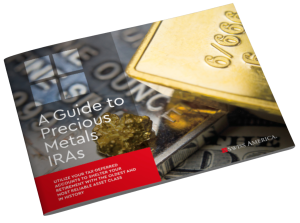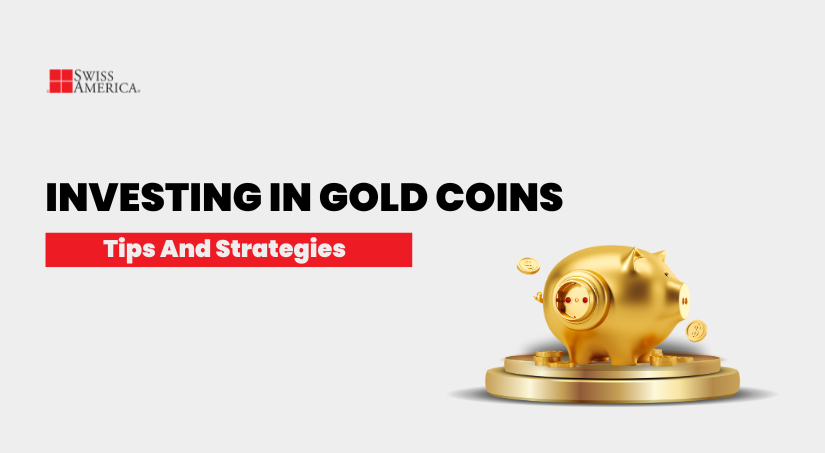
You can add gold to your portfolio in many different ways. But, the best way is when you actually own it as a tangible asset, either by investing in gold coins or bars.
When you own physical gold, you have greater control over what you do with it because you don’t have to rely on someone else to manage, oversee, or dictate its use.
This article covers options for investing in gold coins, why many investors like holding gold to protect their wealth, and the pros and cons of alternative gold investment options.
Introduction to gold coin investing
Gold is a precious metal that investors turn to when they’re worried about what might happen. It’s a defensive strategy to reduce risks and give you peace of mind about your savings. That’s why analysts like Goldman Sachs, UBS, and Citi recommend holding gold and forecast prices to climb throughout 2025.
Specifically, Goldman Sachs research strategists Samantha Dart and Lina Thomas shared:
“In this softer cyclical environment, gold stands out as the commodity where we have the highest confidence in near-term upside.”
For physical gold investments, you can buy gold coins or bars.
Gold coin investing
You have a few options for the types of coins you buy:
Investment grade coins
Gold bullion coins are investment grade because they’re made of pure gold and have value specifically because of their gold content. They qualify for Gold IRAs, so you can use retirement savings to add them to your portfolio. Examples include:
- American Gold Eagle
- American Gold Buffalo
- Austrian Philharmonic
- British Gold Britannia
- Canadian Gold Maple Leaf
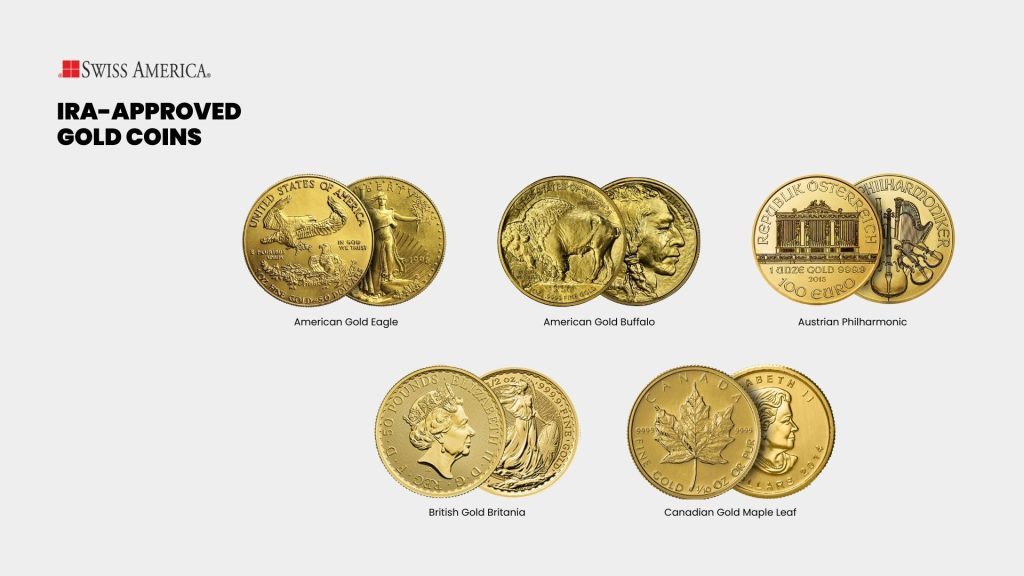
Collectible coins
Collectible coins are also called numismatic coins. They have value for reasons beyond their metal content like historical significance or special edition coins. The drawback of these coins is that they may cost more than they’re worth and might not give you the same type of safe-haven investment as gold bullion coins.
Examples of popular collectible coins include:
- 1794 Flowing Hair Silver Dollar
- 1787 Brasher Doubloon
- 1907 Saint-Gaudens Double Eagle
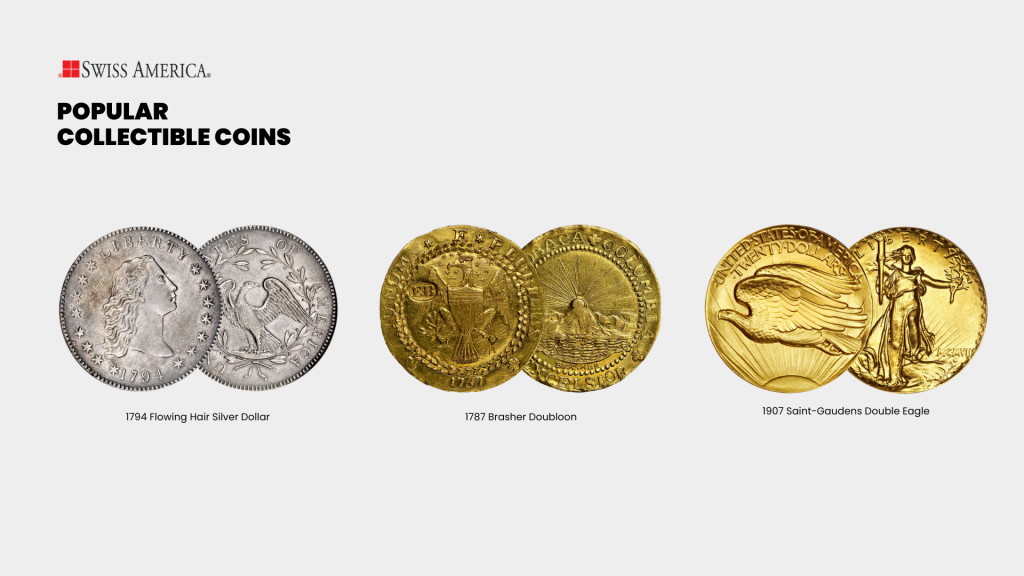
Why invest in gold coins
Why do people buy physical bullion coins? Here are the most common reasons we see:
Hedge against inflation
Gold can help protect your money from the eroding effects of inflation. We only have so much gold in the world and the government can’t just make more like they do with paper currency. This limited availability helps it maintain value so that when costs for all goods and services rise, the cost of gold rises, too.
Take a look at our chart showing gold versus inflation for the last 24 years:
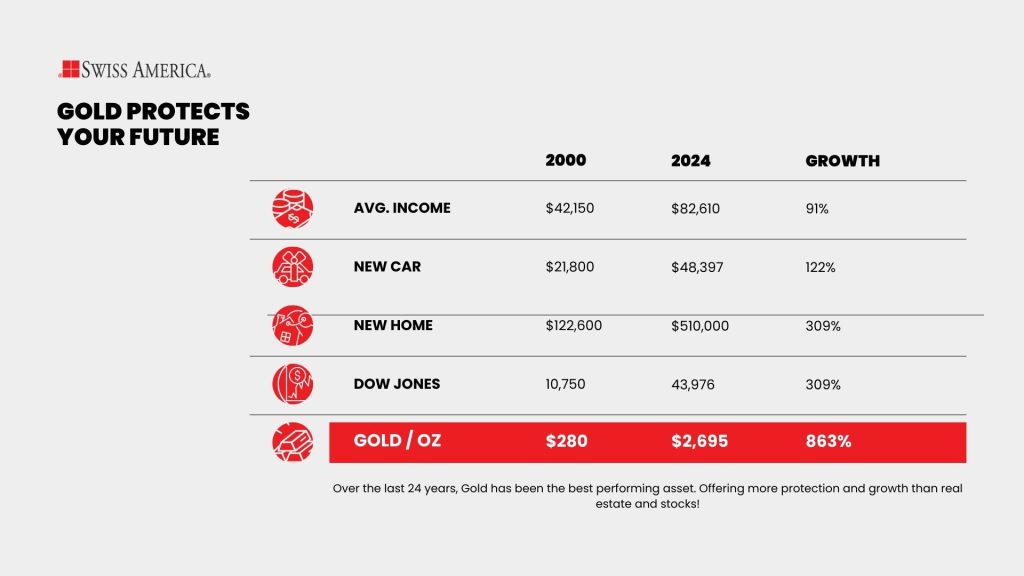
Diversification
Adding physical gold to your portfolio gives you a way to reduce your risks from too much exposure to the stock market. Gold is an independent asset that doesn’t always react the same what’s happening in the world as the stock market or other investments.
Gold investments can do really well when there’s chaos or crises. That’s why you’ll often see experts recommend that you hold a portion of your savings in gold as part of an overall investment strategy. It helps balance out your risks and gives you a way to reduce the impact of stock market corrections on your savings.
Safe haven asset
Gold’s reputation as a safety net means that investors turn to this physical asset whenever there’s bad news. Then, because more people buy gold during whatever that event is, the prices rise. Here’s some recent examples:
Great Recession: During the 2008 financial crisis, the stock market dropped but gold prices rose over 5% and continued to climb in the following years.
COVID-19 Pandemic: When the global pandemic hit in 2020, gold reached all-time highs that year.
2025 uncertainty: 2025 brought us inflation concerns, economic uncertainty, and worries about the national debt.
Considerations for buying gold coins
If you want to add gold to your investment strategy, here’s how to get started:
Ways to buy
Be sure to buy from reputable gold dealers. The best companies have been around for decades, have excellent reviews, and provide educational resources. You want to work with a company that helps support your investment portfolio for the long term.
Price of gold coins
When you look up the current price of gold, this is the spot price. Meanwhile, the actual price you’ll pay is higher because it includes other costs like distribution and shipping. The difference between the spot and your price is called the premium.
Compare pricing from different gold companies to find the best premium for your physical gold investments.
Physical storage options
Once you buy physical gold coins, you’ll need secure storage to protect your investment. There’s a few different options for storing gold:
Home storage: You can keep your gold at home in a good-quality safe. The benefit is that you can physically access your gold at any time, but the drawback is that you run the risk of theft or damage to your gold. If you go this route, make sure to research insurance options because most standard homeowner’s policies don’t cover gold.
Bank storage: Some investors keep their gold in a bank safety deposit box. This helps reduce the risk of theft but doesn’t give you access whenever you want. You’ll also need to consider insurance costs because FDIC insurance won’t cover your gold.
Storage depository: These facilities are purpose-built to store physical gold and other precious metals. They have 24×7 security and include insurance as part of their storage costs. If you’re buying gold in a precious metals IRA, the IRS requires you to keep your gold in one of these facilities.
Gold Coin Storage Options
| Option | Pros | Cons |
| Home storage | Immediate access to gold anytime. | Risk of theft or damage; standard insurance may not cover it. |
| Bank storage | Lower risk of theft. | Limited access hours; additional insurance required since FDIC doesn’t cover gold. |
| Storage depository | High security; includes insurance. | Mandatory for Gold IRAs per IRS regulations. |
Risks and challenges
Like all investments, there are risks when you invest in physical gold bullion coins or bars. Keep these factors in mind:
Market volatility
Gold prices can be stable over the long term, but shorter-term investments face some risks of market ups and downs. The pricing varies depending on investor sentiment and market demand. To some extent, demand for gold jewelry impacts pricing but the investor market is a bigger driver.
For example, gold prices are up over 40% since August 2025, due to factors like central banks buying gold and investor worries about what will happen with the economy.
The World Gold Council tracks gold supply and demand, which can give you a sense of the market’s state, but this data is a few months behind. Since there’s no way to predict what will happen, taking a long-term approach can give you the best returns.
No income
Physical gold and other metals do not produce income. You don’t receive dividends or cash flow. Most investors are OK with this because the whole goal of owning gold bars or coins is to protect your wealth more like an insurance policy. That’s why you’ll often hear experts recommend holding 5%-15% of your portfolio in gold as a defensive strategy to reduce risks.
Selling gold coins
At some point, you may want to sell your coins. Or, if you have a traditional Gold IRA, you’ll have to sell per IRS rules for required minimum distributions. Logistics and areas to keep in mind when you go to sell include:
Market timing
It’s not always possible to time the market, but you can get an idea of what’s happening with key trends that impact gold. Anytime there’s bad news about GDP growth, unemployment, or high inflation, investors usually buy more gold so that can be a good time to sell.
When you’re ready to sell, you can usually sell back to your gold dealer or you can work with a different company to liquidate your coins.
Selling in an IRA
If you have a Gold IRA, you’ll let your custodian know that you want to sell. They take care of the actual selling process and then place the proceeds in your IRA account. From there, you can take a distribution of the funds.
Selling collectible coins
If you’re looking to sell collectible coins, the process is a bit different since these coins have value not for their metal content but more for things like rarity and collector demand. Start with getting a sense of the value of your coins by using resources like “The Official Red Book” or checking out online forums.
From there, you can sell to online buyers or local coin shops. Also, don’t clean your coins because this can reduce their value.
Other ways to invest in gold
Besides owning physical gold, there are paper-based ways you can invest, which include:
Gold ETFs and mutual funds
Gold exchange-traded funds (ETFs) and mutual funds pool money from investors to buy gold assets. ETFs buy actual physical gold, while mutual funds might buy shares in gold mining companies or other gold-related assets.
The benefit of ETFs and gold funds is that you don’t have to worry about storing your gold. But the drawbacks are that you don’t actually own a tangible asset and you’ll need to rely on the performance of the fund manager.
Gold stocks
You can buy individual gold mining stocks with companies that mine or sell gold. This gives you a way to potentially benefit from increases in gold prices. However, this approach relies entirely on the company’s performance and ability to operate efficiently. Even if gold prices rise, if the company can’t meet its obligations or sales targets, your investment is at risk.
Gold futures
Gold futures are a speculative way to invest in gold. You enter into a gold futures contract where you estimate what the price of gold might be in the future. If you’re right, you make money. If you’re wrong, you can lose money.
This way to invest in gold is risky and more like gambling. Plus, you don’t own a physical gold asset.
Gold coins from Swiss America
We mentioned how important it is to work with reputable gold dealers. When you’re ready to buy gold, consider working with the Swiss America team. We’ve been in business for over 40 years and have helped thousands of happy investors buy gold, silver, and platinum.
You’ll find our expert team ready to help answer any questions you have and provide you with resources to support your investment decisions. For example, you can check out our Gold IRA kit, our regular podcast, or our weekday market news updates.
You can be confident in the authenticity and quality of your metals knowing that we are active members of key industry organizations like the American Numismatic Association, Industry Council for Tangible Assets, and the Numismatic Guaranty Corp.
Final thoughts on investing in gold
People buy gold to reduce the risk to their savings from the eroding effects of inflation or the panic that hits the stock market when there’s bad news. You never know when the next recession or world crisis will occur until it’s here. That’s why gold is a defensive strategy to protect your wealth.
If you want to learn more about investing in gold coins, bars, or other metals, connect with the Swiss America team today!
Investing in gold coins: FAQs
How much gold can you buy for $1,000?
As of this writing, the current spot price of gold is $3,452. You could buy smaller bars like 1/10 or 1/4 ounce, depending on the premium and other costs like taxes.
How do beginners buy gold?
Beginners can start by reading resources and materials that reputable dealers like Swiss America offer. You can also talk with one of our experts to learn more about your options. From there, you can open an account, buy gold and then store your gold until you’re ready to sell.
Can gold be a good investment?
Yes, gold can be a good investment. Like all investments, it has risks and costs, but if you take a long-term view and add gold to help balance your portfolio, it can help protect your wealth from inflation or stock market ups and downs.
The information in this post is for informational purposes only and should not be considered tax or legal advice. Please consult with your own tax professionals before making any decisions or taking action based on this information.
